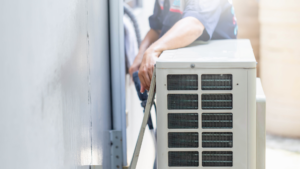 High-velocity air conditioning is one of the latest innovations in home comfort. Compact and powerful, it lowers temperatures in minutes in spaces where central air conditioning is either impractical or cumbersome. Installing a high-velocity air conditioner provides quick relief from rising temperatures, at a lower monthly cost than traditional cooling systems. For curious homeowners, this short guide offers a full rundown of both its benefits and their costs, to help determine whether high-velocity air conditioning is the right solution for you.
High-velocity air conditioning is one of the latest innovations in home comfort. Compact and powerful, it lowers temperatures in minutes in spaces where central air conditioning is either impractical or cumbersome. Installing a high-velocity air conditioner provides quick relief from rising temperatures, at a lower monthly cost than traditional cooling systems. For curious homeowners, this short guide offers a full rundown of both its benefits and their costs, to help determine whether high-velocity air conditioning is the right solution for you.
How High-Velocity Air Conditioning Works
A high-velocity air conditioner works on the same principle as a central air conditioner. Air from inside your home is drawn in through a series of intake ducts connected to the air handler, which houses the condenser and evaporator coils, as well as the blower fan and filter. As the air passes through the handler, the refrigerant absorbs its residual heat, which it dissipates after moving through the condenser. The cool air is then circulated through your home by the blower fan, before being sucked back into the intake ducts to repeat the process.
What separates high-velocity air conditioning from conventional air conditioning is the size of its ducts. Central air systems use ducts with six-inch diameters, fed by trunk lines that are normally 8 x 18 inches. High-velocity systems, on the other hand, use ducts and lines that are only 2-3 inches in diameter. Pumping air through such narrow spaces increases the pressure inside your cooling system, which accelerates air circulation.
Advantages of High-Velocity Air Conditioning
The main benefit of high-velocity air conditioning is how quickly it lowers temperatures. Delivering air faster ensures greater comfort and more control over your environment. But installing a high-velocity system does more than improve air flow. It also:
- Reduces Waste. It’s estimated that air circulating through conventional duct systems loses 30-40 percent of its energy. Because of their size, high-velocity ducts are easier to seal, which means fewer leaks. At the same time, their smaller surface area minimizes heat transfer with outside air.
- Eliminates Hot Spots. Rapid air circulation prevents uneven cooling in different rooms of your house. Displacing warm air allows you to maintain a consistent temperature while running your air conditioner less often, which helps lower energy costs.
- Retrofits into Existing Homes. High-velocity ducts are small and flexible enough to fit between existing studs, joists, and rafters, which means they can be installed without tearing away plaster and drywall. Unlike conventional ductwork, high-velocity ducts can be snaked through walls and ceilings, giving homeowners more freedom when it comes to vent placement.
- Saves Space. Besides their narrow ducts, high-velocity systems also have more compact air handlers, which makes them an ideal choice for older houses with less room for new construction.
- Lowers Humidity. Continuous movement of air prevents humidity from accumulating in your home. Because it cools and returns air so quickly, a high-velocity air conditioner removes up to thirty percent more moisture than a conventional AC system.
Costs of High-Velocity Systems
Before installing a high-velocity air conditioner, there are a few considerations homeowners need to take into account. Along with stronger airflow, high-velocity systems are also:
- Noisy. Air moving rapidly through narrow vents is often more discernible than it would be flowing through larger ones. Though not especially loud, it can be distracting for some.
- Costlier. Though high-velocity systems are cheaper to operate, they’re more expensive to install. Costs vary depending on the size of the system, but can be almost twice as much as a central air conditioner.
- Conspicuous. Due to their size, high-velocity vents are less visible. However, their fast-moving airflow is far more noticeable than it would be coming out of an ordinary vent. Careful placement can prevent air from disturbing the occupants of a room, but it will always be perceptible, at least to some degree.
Despite these caveats, high-velocity air conditioning is being embraced by many homeowners interested in comfort and long-term savings. Consult an HVAC contractor to determine whether a high-velocity air conditioner is the best choice for your home.